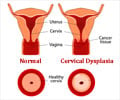In an analysis based on a computer model, it appears that comparing the benefits and risks of different cervical cancer prevention
In an analysis based on a computer model, it appears that comparing the benefits and risks of different cervical cancer prevention approaches may help women and their physicians choose appropriate screening strategies, according to a report.
Routine screening with cervical cytologic testing, commonly known as Pap smears, is credited with reducing the incidence of cervical cancer through the early detection of abnormal cells, according to background information in the article. Today, U.S. women have an average lifetime cervical cancer risk of 0.7 percent. Recently, even more sensitive DNA testing for the human papillomavirus (HPV), which contributes to cervical cancer, has become available, along with vaccines against HPV. This leaves women and their physicians with several prevention options and considerations.Natasha K. Stout, Ph.D., and colleagues at the Harvard School of Public Health, Boston, used a computerized simulation model of cervical cancer in the United States to assess the benefits and risks associated with various screening strategies. The strategies differed by type of primary screening test, process for handling abnormal results and screening frequency. “These strategies pose trade-offs between minimizing cancer risk (already small with regular screening) and minimizing the risk of false-positive test results and excessive diagnostic procedures,” the authors write.
Differences in women’s lifetime cancer risk varied little between screening strategies; however, the difference between the strategy offering the least and most frequent referrals for colposcopy (a procedure in which physicians look directly at the cervix through a microscope) was three-fold. For a representative group of 1,000 20-year-old women undergoing annual screening for 10 years, combined cytologic and HPV testing would lead to an estimated 1,795 referrals for colposcopy and other follow-up procedures (1,788 of them excessive, or not associated with cancer). The same women would receive 403 referrals (396 excessive) from cytologic testing following by triage HPV testing for those with abnormalities; 333 referrals (326 excessive) from conventional cytologic testing; and 223 referrals (216 excessive) from HPV testing followed by cytologic triage testing.
“For women who experience short-term anxiety around screening and diagnostic workup, quality of life could be an important criterion for decision making if several screening options associated with similar cancer risk reduction are available,” the authors write. “Using cytologic testing followed by triage testing in younger women minimizes both diagnostic workups and positive HPV test results, whereas in older women diagnostic workups are minimized with HPV DNA testing followed by cytologic triage testing.”
“There is great promise in the availability of accurate HPV diagnostics, new screening technology and HPV vaccination for successful cervical cancer prevention in the United States. From both an individual and population perspective, the range of new options for prevention will ideally be assembled in such a way as to improve cancer outcomes, reduce disparities and minimize the risk of overdetection of abnormalities likely to resolve on their own,” they conclude.
“These results provide an initial step toward a comprehensive set of clinically relevant information highlighting trade-offs among screening policies to ultimately better inform women’s decisions and provide additional dimensions for the construction of clinical guidelines.”
Advertisement
LIN














